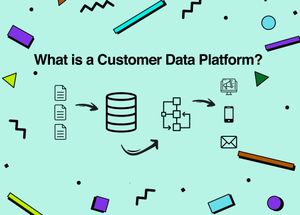What is a Customer Data Platform? What does it do? And does every martech stack need one?
This playbook aims to give a basic overview Customer Data Platforms (CDP).
When used in the right way a CDP can unify your data, give you a clearer view of your customers and deliver personalised real-time communications.
However there are some considerations around how CDPs and whether it's the right technology for your martech stack.
What is a CDP?
A Customer Data Platform is defined by the CDP Institute as:
Packaged software that creates a persistent, unified customer database that is accessible to other systems.
OK, let's break that down a bit more... 🤨
Packaged software
Packaged software means the functionality of a CDP is combined under one piece of software. This is important to note because you can create functionality of a CDP without it being packaged software. At the moment some call this functionality without being packaged software a 'composable CDP' or 'uncoupled CDP'. We'll cover this further below.
Persistent (Indefinite data storage)
Persistent means the data ingested can be stored as long as you want (excluding other factors such as compliance, privacy or other legal requirements).
Unified customer data
Unified customer data is the ability to unify data under a single identifier or the same individual.
This is one of the reasons by CDPs are associated with the term single view of the customer.
Accessible to other systems
Other systems can load data and the CDP also connects to other systems.
Use cases of a CDP
Having one unified profile per customer has marketing advantages - for example let's say your customer has several interactions with you. Perhaps 1. They browse on one of your websites, 2. They have profile data with their date of birth, 3. They have bought something in the past.
Using a CDP you could create an audience which combines these attributes such as All visitors to the website who are over 18 and have had a sales purchase in the last 1 year. Then you can target that audience within different marketing channels you may have connected to such as Facebook, Google, your CRM, and so on.
The applications of marketing strategy via a CDP is limitless - retention targeting for users who haven't visited in awhile, customised messaging for users who like specific types of products, or notifications for people who have just recently visited your site.
Cool huh?
CDP vs Cloud data warehouse
Before you even consider getting a CDP, understand that there is an ongoing debate right now about whether CDPs are the right solution for long term data unification and segmentation.
There are currently 2 x ways of achieving the same functionality (collect data, transform data, activate data to marketing channels):
- Purchase a CDP with this combined functionality.
- Build a 'composable CDP' using separate components (data collect, data transform and data activate services).
There are advantages to both of these approaches. Note that these approaches are often supported by the vendors who sell this technology, regardless of whether it's the best for your organisation. Some even claiming that CDPs are dead.
So what's the better option for your organisation? Martech Playbooks plan on writing a playbook specifically about these two options. However, in the interim we recommend you exploring the advantages of both options.
Pros of a CDP 👍
Note: Not all CDPs are equal and some have strengths in certain areas. Some are more focused on the data side and some more the segmentation side. Be sure to investigate the capability and features you need.
- Integrations - The superpower of a good CDP is the ability to ingest any type of data as well as its many connections to multiple owned and paid marketing channels.
- Accessibility - As a CDP is separated to a data warehouse, it's very accessible to marketing teams who wish to have more control over their data.
- Support - The majority of CDP vendors offer ongoing technical support for any issues that may arise with the CDP.
- Segments - CDPs allow for you to create audience segments, so you can retarget your users, visitors or customers.
- Automation - Once configured in the correct way, CDPs can enable automated marketing from the user interaction to the end channel delivery.
- Real-time load and access - Many CDPs are real-time load both real-time access, allowing for speed of communication.
- Profile matching - Some CDPs offer sophisticated matching, including matching names with various differences or cross device identifiers.
- Implementation - Compared to building a CDP from multiple components, it's much easier to purchase and ingest data.
Cons of a CDP 👎
- Data replication - One of the biggest arguments against getting a CDP is that you have another platform outside your data warehouse which can cause data replication and duplicate data management efforts. It may be advantageous to ensure your data warehouse is the center of your martech stack.
- Known users and channel match - one of the biggest problems with activating marketing using a CDP is that you still need to have either known or consented audiences to communicate to them. So if someone new visits your site, doesn't create an account or doesn't consent to 1st party cookies - then the CDP won't work. Also once you do have these audiences in a CDP, there is still a variation between your 1st party audience and what you could communicate in a connected marketing channel. If you have a low account base, you must consider the size of your contactable reach prior to getting a CDP.
- Usability - while the usability of a CDP is easier than navigating a data warehouse, the operation of CDPs can be difficult. Many CDPs require a several months to master, particularly for marketing professionals without experience within these platforms.
- Limited reporting - despite the CDP being a database, the level of reporting on the majority of CDPs is quite basic. Many offer dashboards on the size of audiences however if you are looking for decent marketing reporting you'll need additional tools or CDP add-ons.
- Expensive - don't be surprised by the cost of a CDP, according to Gartner they can range between USD$100,000 to $300,000+ per year.
- 3rd party software - a CDP is not built or customised software so you will be subject to the software you buy and all it's limitations. However many have ongoing updates and releases to continually improve its functionality.
Recommended CDP support
Having a smooth implementation of the CDP is necessary to success. Ideally you should have your use cases ready and a clear implementation plan.
Example implementation team
- Vendor support team, data engineer, data analyst, platform owner, CRM/personalisation marketer and product manager.
Ongoing support
Once your CDP is set up, it's not a set and forget platform. It will need ongoing specialists to use it and deliver value.
- Platform owner - At least one platform owner who is admin of the platform.
- Campaign managers - At least 2 x campaign managers to create segments, QA and activate.
- Data analyst - To help with complex logic and size opportunities, you'll need a dedicated data analyst.
Consider the indirect impacts of the CDP
- Creative support - You will need to have scoped required creative support if you plan on separate messaging for the segments you create.
- Channel managers - The channel managers that work with the CDP team who activate data to marketing channels.
- Data engineers - for any new data loads you may require a data engineer depending on the complexity.
- Privacy and security - Any platform that uses data and sends to other systems needs input from a security and privacy delegate.
CDP vendors
Martech Playbooks provides education and is 100% vendor neutral. Here are some known vendors in the CDP space:
- Bloomreach
- Blueconic
- Amperity
- Acqiua AgilOne
- Blueshift
- Cheetah Digital
- Commanders Act
- Cordial
- Informatica
- Lexer
- Lytics
- mParticle partner certification
- Segment
- Tealium
Don't forget to check out the CDP vendor lists from G2 and Capterra.
CDP vendor evaluation checklist
If you are exploring getting a CDP, The CDP institute has great resources on use cases, vendor selection, and training.
Martech Playbooks verdict
With the right implementation and support, a CDP can empower your marketing team to deliver segmented communications through your digital channels. With a CDP marketers can have more control over their organisations data.
However there are possible traps with a CDP, including difficult usability, replicating data efforts outside your data warehouse and also failure to activate if your organisation has low known users.
Want a Martech Playbooks expert do a comprehensive audit of your situation? Contact us.
Additional CDP resources
- Customer Data Platform institute (This is a must for anyone investigating procurement of a CDP)
- Customer Data Platforms Martin Kihn and Christopher O'Hara (Note that while informative, this is a bit of a plug for Salesforce)


